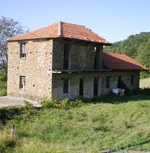Maintaining your country house
Cheryl Markosky discovers how to keep your country house in good condition


When William Morris founded the Society for the Protection of Ancient Buildings in 1877, he spoke of the need ‘to stave off decay by daily care to prop a perilous wall or mend a leaky roof’. Such attention to regular maintenance of country houses has always been important, although it could be even more critical today when buyers with less cash are likely to be put off by a property in a sad state of repair.
Little and often is the key to good upkeep, says Grant Bentley from Knight Frank’s country-house consultancy division. He recounts horror stories of how debris in hidden valley gutters and the wrong materials have resulted in owners being stuck with bills of more than £20,000 to stamp out dry and wet rot. ‘Turning a blind eye won’t help sell your house, particularly older buildings evolving over time that require sympathetic care,’ he argues.
Essentially, you want to keep water out of the parts of the house that aren’t supposed to get wet, according to building surveyor and project manager Tim Lawson from Property Pathfinder. ‘Get up a ladder and replace split tiles, keep a watchful eye on pointing, unblock down-pipes and stay up to date with exterior painting to keep damp at bay.’
It’s easy to think the inside of a house is safe if the outside is in good repair, but plumbing and heating faults are the most common causes of water damage. ‘Similarly, faulty wiring can cause a fire. A high-quality installation, together with regular inspections, is the best protection,’ advises architect and designer Janine Stone.
As the owner of a listed building, you could be handed a hefty fine or even face imprisonment if you carry out work without permission or install uPVC instead of hardwood windows. Yet, Kevin Allen from John D. Wood & Co points out the pluses: ‘Although you may be little more than the custodian of the property for the next generation, you’ll be the envy of your friends that in itself has to be worth a little financial sacrifice.’
Have trust in the National Trust
Homeowners keen to lick their disintegrating country houses into shape should take heed of the National Trust’s routine maintenance programme for the upkeep of historic houses. Regular repairs to prevent weather damage have always been important, but it has become more crucial with increasingly severe conditions. ‘We regularly clear twigs and birds’ nests from gutters and downspouts and remove heavy moss growth from roofs, particularly in the spring and autumn,’ says the Trust’s head conservator Katy Lithgow, based at the charity’s new sustainable headquarters at Heelis in Swindon.
Exquisite houses, the beauty of Nature, and how to get the most from your life, straight to your inbox.
Painted metalwork is inspected at least every two years and renewed every five to 15 years. External stone and metal garden statuary requires annual checks to remove damaging accretions, followed by waxing, she adds.
The Trust tackles frost damage and slippery algae growth on stone and brick steps and garden paths, and render is lime-washed and surface cracks treated at least every decade, or whenever problems are detected.
Naturally, good weather is needed for any of these interventions. Frost and the risk of condensation generally mean that any treatments should be carried out between April and October.
‘Whatever the recommended intervals, nothing beats keeping a regular eye on things,’ says Miss Lithgow. ‘Whenever you’re passing, look out for green stains round downspouts that suggest there may be leaks, and for any losses and bulges in surface finishes. But the best time to see whether gutters and roofs are performing is when it’s raining.’
Top upkeep tips
* Repair gutters and downspouts it’s cheaper than repointing and replacing perished bricks
* Replace missing roof slates and tiles
* Maintain water softeners that extend the life of central-heating systems and appliances
* Check alarms, electrics and water detectors that have an impact on property insurance
Country Life is unlike any other magazine: the only glossy weekly on the newsstand and the only magazine that has been guest-edited by His Majesty The King not once, but twice. It is a celebration of modern rural life and all its diverse joys and pleasures — that was first published in Queen Victoria's Diamond Jubilee year. Our eclectic mixture of witty and informative content — from the most up-to-date property news and commentary and a coveted glimpse inside some of the UK's best houses and gardens, to gardening, the arts and interior design, written by experts in their field — still cannot be found in print or online, anywhere else.
